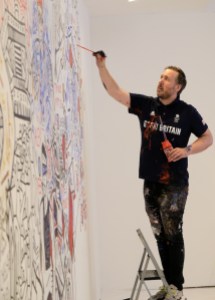Rakewell, Apollo’s wandering eye on the art world, takes a rakish look at art and museum stories.
It is fairly well known that in the first half of the 20th century, artistic competitions were part of the Olympic Games, with competitors battling it out in painting, sculpture and architecture categories. In 1949, however, the International Olympic Committee (IOC) decided that the arts should not be eligible, since almost all the competing artists were professionals, and that was that. Nowadays, no one really thinks it odd that art isn’t in the Olympics, except for the singer Pharrell Williams, who at a Louis Vuitton event last week in Paris appeared to get behind the idea of art returning to the Olympic roster for the LA games in 2028 – a bold suggestion, even if the singer did cushion the shock by prefacing his proposal with the words, ‘It might seem crazy what I’m about to say.’
The jettisoning of art from the Olympics may seem like confirmation that the importance society accords to creativity has, over time, been slowly chipped away. But Rakewell would posit that in fact, the decision has allowed art to enter the Olympics in stranger and more beautiful ways. Art is and always has been at the heart of the games – you just need to know where to look.
Official Team GB Ben Mosley painting a mural in a shop on Carnaby Street, London, during the Tokyo Olympics in 2021. Photo: Matthew Chattle/Future Publishing via Getty Images)

Who among us knew, for example, that Team GB employs an official artist – and has done since the 2012 games? Ben Mosley went to London Olympic events and produced on-the-spot paintings of British athletes; for the Covid-hit Tokyo games, he produced a 50m-long live mural in Carnaby Street, London, documenting every medal won by Team GB as it happened; and now, Mosley has crossed La Manche to paint victorious Britons again, though he has chosen to stick with his riotously colourful graffiti-inspired approach rather than use the thousand-tiny-dots method that the French seem to like so much.
Were Pharrell’s wish to come true, however, things might need to be adjusted to take in more contemporary art trends. One artist, Abraham Poincheval, understands the value of conceptual art, having mounted a daring performance piece spanning the first 10 days of the Paris games that involved him being sealed in a large transparent glass bottle floating on the Canal Saint-Denis. La Bouteille is not his first such endeavour: in 2014 he spent 13 days living, Revenant-style, inside a taxidermied bear. But unlike Leonardo DiCaprio’s character in that film, Poincheval had his fleshly home decked out with a kettle and other amenities.
The most powerful bond between art and the Olympics, however, comes from the athletes themselves, several of whom are knowledgeable about art and even have degrees in the subject. Take one prime example: the British rower Emily Craig, who won gold alongside Imogen Grant last week in the lightweight double sculls, has an undergraduate degree in art history from the Courtauld and an MA in East Asian Art from Sotheby’s. Those, like the former prime minister Rishi Sunak, who decried useless ‘Mickey Mouse’ courses should take note. Do an art degree and you might just end up a sporting hero.
Got a story for Rakewell? Get in touch at rakewell@apollomag.com or via @Rakewelltweets.




